跨文化交际 复习资料
跨文化交际复习资料

《跨文化交际》复习资料Paper 1 Communication AnalysisThe following are three different cases of cross-cultural communication. In each of the cases there is something to be improved upon. Write an analysis on what is to be desired for more successful communication or cultural understanding.Question 1Case 1:Chen Bing, a Chinese tour guide, is talking to a Canadian tourist, Luke Baines, who has no knowledge of Chinese at all. They are having dinner in a restaurant.Chen: This is Beijing duck, one of China's most famous dishes. You'll love it!Luke: No, thanks. I don't like duck. I prefer chicken.Question 2Case 2:Feng Li and Tom have been working on a scientific experiment at a British university for some months. It has not been totally successful. They are discussing the situation in the laboratory.Feng Li: I don't know where it went wrong!Tom, Don't feel so bad. Cheer up, you've done your job.Feng Li: But our experiment has turned out to be a failure.Tom: Relax for a couple of days. I'll face the music.Feng Li: Tom, we are not playing children's games here. This is a scientific experiment.Tom, I've never taken the experiment as child’ s play, and I'm playing the game.Feng Li: You say you're playing the game! It's a rather important experiment!Feng Li walks out of the Laboratory angrily. Tom is puzzled.Question 3Case 3:This is a more complex situation where there are several things that require more informed cultural analysis. Find the cultural problems and explain the cultural differences. Jim and Li Zhen were students together at Leeds University in Britain. A year later, after graduating, Jim went to Shanghai as a visiting scholar on a year’s exchange.Jim had never been to China before. Li Zhen took him to a classical piano concert performed by a famous Chinese pianist. During the performance people were talking and at one stage someone ran up onto the stage and presented the pianist with a bunch of flowers during the playing of a particular musical item. This happened several times during the evening. It also happened when two singers were on stage singing some songs that he was playing. Jim thought all these things quite strange. At the end of the performance the audience applauded the pianist and he applauded them. The audience began to leave while the pianist remained on the stage.Paper 2 VocabularyChoose one word or expression from those in the box below to fill the gap in each of the sentences. Write the correct words in the spaces provided in your answer sheet. Do not change the forms of the4. After twenty five years working in the bank she decided on a different .5. Finally, after arguing about the meal for five minutes it was decided he would .6. Despite the circumstances of the accident there were still some that needed explanation.7. There are many different used when talking about people's relationships in China.8. "Mike! Meet Jane, the ."9. "Ok, the argument is over. Let's forget it, you know."10. People in English speaking countries also avoid losing face or hurting other people by telling .11. It is difficult for foreigners to understand British pub culture, especially the system of which all members of the group are expected to join in.12. It was a crushing blow to her, a hit when she received thenews that her husband had left her for another woman.13. In China there is a real sense of in social situations. Paper 3 TranslationTranslate the following passage from English into Chinese. Please write your translation on the answer sheet.What do we mean by "Intercultural Communications" or "IC"? This is not a description of the popular trend toward talking about international things or going overseas. IC is actually an academic and applied discipline that has developed internationally since the 1950s. Sometimes called "cross-cultural communications" or "comparative culture" , scholars most often use the prefix "inter" with the word "cultural" to describe the interaction between cultures. On one level, IC is represented by culture studies, where we examine the political, economic and lifestyle systems of other countries. On another level, it is applied linguistics, where we seek to understand the relationship between language and culture. Many Chinese English teachers and professors have been interested in this aspect since the 1980s - How to teach English in ways that help students also learn the basic communication practices of Britain, the US or other English speaking countries.But the discipline of Intercultural Communications is actually a broad and well-developed field of study. IC is an interdisciplinary application of fields like cultural anthropology, sociology, psychology (and social psychology), communication studies, applied linguistics and educational pedagogy. IC is a comprehensive attempt to understand all aspects of human cultures and how they interact with each other.To understand Intercultural Communications, we seek to understand tradition and modernization, consistency and change. As we understand some of the ongoing national characteristics of a people, we can examine how this culture is seen from the outside, how it interacts with other cultures and how it is changing. In the last thirty odd years, scholars have developed both theoretical framework for comparing cultures and some practical dimensions for considering the similarity and differences between them. One level of intercultural comparison is Cultural Identity. Another level of comparison is Verbal Communication. Another area receiving much attention is Nonverbal Communication. Paper 4 ReadingPassage 1 Questions 15-20In recent years criticisms have been voiced concerning sexist bias in the English language. It has been argued that some of the vocabulary and grammar we use reflects and reinforces a traditional view of the world asone in which men are dominant and women play a secondary role. Take the word 'chairman' for example. While this can in fact apply to people of both sexes, it appears to some people to be male-oriented as it ends in 'man'. In the past people taking the role of chairman were exclusively male and the word was obviously originally a compound of 'chair' and 'man'. Many English speakers, however, have ceased to view this word as a compound and no more feel it to be composed of these two units, than they perceive cupboard to be a composite of ' cup' and ' board'. In addition the continued use of chairman might be defended on the grounds that the final syllable is pronounced /m'n/ rather than /mn/, just like the final syllable of woman. Despite such considerations other speakers take a contrary view and are sensitive to the components of which it is made up. They clearly perceive it as a title that perpetuates traditional ideas about the place of women in society. For this reason they seek to replace it with neutral terms such as 'chairperson' or 'chair', so that it is now possible to ask questions such as; 'Who is chair of the committee?' Other changes advocated include the replacement of words such as 'postman', 'fireman' and 'policeman' with more clearly neutral terms such as 'postal worker', fire-fighter' and 'police officer’. There is, however, continuing controversy about how far such language changes should go. Should changes be considered for traditional idioms as 'man in the street' and titles such as 'Peking Man'? What about those words where the male meaning of 'man' is no longer dominant, such as 'manhandle'?To the extent that changes have taken place, they have done so more in the written language and formal pronouncements than in everyday speech. You would be quite likely to read in the paper that 'Postal workers are to receive a pay increase.' But 'Has the postman been?' would be most likely to be heard in informal conversation. Here 'postman’ remains firmly entrenched in popular usage.The extent to which language reflects and shapes attitudes and behaviors is a matter of conjecture. Chinese, Japanese, Persian and Turkish do not make the kinds of sex distinctions English makes through its system of pronouns, but it would be difficult to maintain that males who speak these languages are less sexist than males who speak English! Answer the following questions according to the above text:15. The general use of the word 'man' added to English words indicates .A. sexual feelingsB. sexual freedomC. sexist ideasD. sexist bias .16. Generally where language and sex are concerned in Britain .A. all people agree change is neededB. some people agree change is neededC. people can't make up their minds on the issueD. people think the issue is unimportant and not serious17. What example does the author give to support a defense of the word 'chairman'?18. What does the author argue for when the example 'manhandle' is given?19. What does the author have to say about the impact of language changes?20. What is the author's argument in the final paragraph?Passage 2 Questions 21-27Can Computers Do a Better Job Rating Stocks?Since May, Charles Schwab has been providing stock ratings to clients using a computerized system that it says tries to remove human bias.In particular, Schwab says, its system is meant to avoid the conflicts of interest that have plagued traditional brokerage firms, whose research analysts have often acted as cheerleaders for companies being courted by their investment bankers."We believe that our single biggest advantage is our objectivity," said Jerry Chafkin, Schwab's executive vice president for investment advice and products. " While the development of the methodology is human, the analysis is being performed systematically and automatically.Though Schwab is perhaps the most prominent financial services company to use a computer-driven rating system, several others, including Value Line and Zacks Investment Research, pick stocks in a similar way.The various systems produce very different ratings of individual stocks, and their ability to outperform a market index fund over time has not been proved conclusively. The verdict is still out as to whether computers do it better than people. What is clear, though, is that the major computerized systems hand out fewer positive stock ratings than do Wall Street analysts, who seem to give them out very generously.People who run computerized selection systems criticize traditional Wall Street analysis as having institutional conflicts of interest, as well as individual bias. "I am very suspicious about opinions and judgments and emotions by humans in individual stock selection," said Samuel Eisenstadt, Value Line's research director.However, the computer-driven stock-picking systems must rely on the selection criteria of their creators. All try to isolate factors that their developers believe have the greatest ability to predict share prices. Most models compare a company9s historical earnings growth with that of other companies. And many track the extent to which earnings havesurprised analysts.Many firms use their computer-based stock-rating systems as marketing tools.The designers of these systems say they should be judged on how a group of stocks performs over time. But all the systems assume, as do stock analysts on Wall Street, that superior research, by humans, and analysis can select a group of stocks that will outperform the market averages over the long run.Market analysts say it is too soon to assess the fledgling Schwab system or new models, like Microsoft's year-old Stock-ScouterMark the following statements True (T) / False (F) / Not Given (NG) according to the information provided in the text.Write T, or F or NG on your answer sheet in the spaces provided for questions.21. Charles Schwab is a computer company.22. The method of operation by Schwab is done automatically.23. 'Value Line' and 'Zacks' have similar operating methods to Schwab.24. There is no conclusive proof that computers perform better than humans.25. Wall Street analysts are generous in rating stocks.26. Human beings make value judgments according to the research director of 'Value Line'.27. Analysts are surprised at the growth rate of share prices.答案及评分标准Paper 1: Communication Analysis●The following points should be covered in the analysis.●Award one point for each of the points covered (underlined). Paper 2: Vocabulary●One point for each item.●Answers must be the same as the key.4. vocation5. foot the bill6. grey areas7. kin terms8. trouble and strife 9. live and let live10. white lies 11. buying a round12. below the belt 13. communityPaper 3: Translation14.“跨文化交际”或“IC”是指什么呢?这并不是对于谈论国际事务或出国大潮的描述。
跨文化交际复习资料(最新版)
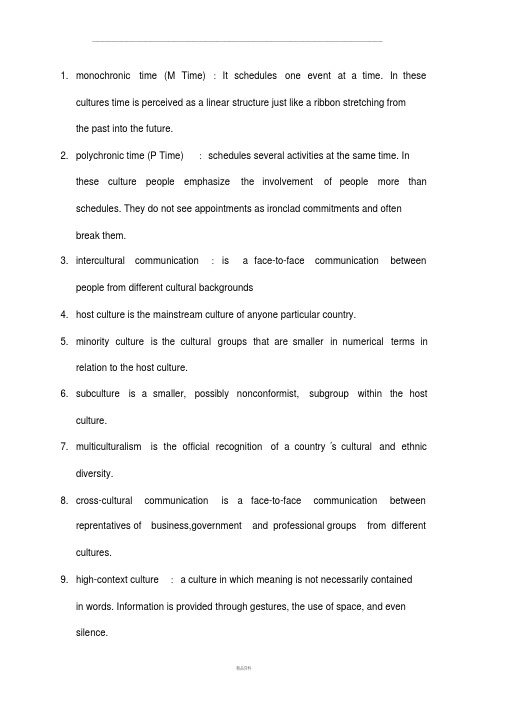
1.monochronic time (M Time) :It schedules one event at a time. In thesecultures time is perceived as a linear structure just like a ribbon stretching fromthe past into the future.2.polychronic time (P Time) :schedules several activities at the same time. Inthese culture people emphasize the involvement of people more than schedules. They do not see appointments as ironclad commitments and oftenbreak them.3.intercultural communication :is a face-to-face communication betweenpeople from different cultural backgrounds4.host culture is the mainstream culture of anyone particular country.5.minority culture is the cultural groups that are smaller in numerical terms inrelation to the host culture.6.subculture is a smaller, possibly nonconformist, subgroup within the hostculture.7.multiculturalism is the official recognition of a country’s cultural and ethnicdiversity.8.cross-cultural communication is a face-to-face communication betweenreprentatives of business,government and professional groups from different cultures.9.high-context culture :a culture in which meaning is not necessarily containedin words. Information is provided through gestures, the use of space, and evensilence.10.low-context culture :a culture in which the majority of the information is vestedin the explicit code.11.perception: in its simplest sense,perception is ,as Marshall singer tells us,”theprocess by which an individual selects, evaluates,and organizes stimuli fromthe external world” In other words, perception is an internal process wherebywe convert the physical energies of the world into meaningful internal experiences.Non-verbal communicationIt refers to communication through a whole variety of different types f signal comeinto play, including the way we more, the gestures we employ, the posture weadopt, the facial expression we wear, the direction of our gaze, to the extent towhich we touch and the distance we stand from each other.. IndividualismIndividualism refers to the doctrine that the interests of the individual are or oughtto be paramount, and that all values, right, and duties originate in individuals. It emphasizes individual initiative, independence,individual expression, and even privacy.13. ParalanguageThe set of nonphonemic properties of speech, such as speaking tempo, vocal pitch, and intonational contours, that can be used to communicate attitudes orother shades of meaning.12.人际交际interpersonal communication: a small number of individuals who are interactingexclusively with one another and who therefore have the ability to adapt their messagesspecifically for those others and to obtain immediate interpretaions from them.指少数人之间的交往他们既能根据对方调整自己的信息,又能立即从对方那里获得解释。
跨文化交际复习资料

跨⽂化交际复习资料U1Economic globalization: the integration of national economies into the international economy through trade, foreign direct investment, capital flows, migration迁移;移民;移动, and the spread of technology.Global village: all the different parts of the world from one community linked together by electronic communication, especially the internet.Melting pot: a social cultural assimilation同化作⽤of people of different backgrounds and nationalities. Cultural Diversity: refers to the mix cultures and sub-cultures of a group or organization or region. What are the four trends that lead to the development of the global village? (P8-9)The concept of culture:a learned set of shared interpretations解释about beliefs, values and norms, which affect the behavior of a relatively large group of people.What are the three ingredients of culture?Artifacts: the material and spiritual精神的,⼼灵的products people produce.Behavior: what they doConcepts;beliefs,values,world views…what they think⽂化冰⼭(Cultural iceberg)P7Characteristics of cultural:Culture is shared: All communications take place by means of symbols.Cultural is learned: Culture is learned, not inherited. It drives from one?s social communication, not one?s genes. Enculturation(⽂化习得):All the activi ties of learning one?s culture are called enculturation.Culture is dynamic (P6): Culture is subject to change. It?s dynamic动态;动⼒rather than static静态的, constantly不断地;时常地changing and evolving进化;展开under the impact of events and through contract with other cultures.Acculturation(⽂化适应):The process which one adopts the changes brought about by another culture and develops an increased similarity between the two cultures.Culture is ethnocentric(⽂化中⼼主义):Ethnocentric is the belief that your own cultural background is superior. Communication: meaning to share with or to make commotion, as in giving to another a part or share of your thoughts, hopes, and knowledge.Intercultural communication: communication between people whose cultural presumptions假定推定and symbol systems distinct enough to alter the communication event. (P9-10)Components of communication:Source: the source is the person with an idea he or she desires to communicate.Encoding: Encoding is the process of putting an idea into a symbol.Message: the term message identifies the encoded thoughts.Channel: the term channel is used technically to refer to the means by which the encoded message is transmitted.Noise: the term noise technically refers to anything that distorts曲解the message the source encodes. Receiver: the receiver is the person who attends to the message.Decoding: the receiver is actually involved in the communication process by assigning meaning to the symbols received. Receiver response: it refers to anything the receiver does after having attended to and decoded the message. Feedback: it refers to that portion of the receiver responds of the resource has knowledge and to which the source attends and assigns meaning.Context: Generally context can be defined as the environment in which the communication takes place and which helps define the communication.Characters of communication:Communication is dynamic, symbolic, irreversible可逆的, systematic, transactional, and contextual. Unit 2-4 verbal communicationPragmatics⽤学;语⽤论: the study of the effect that language has on human perceptions and behavior. Semantics语义学;语义论: the study of the meaning of words.Denotation符号;表⽰;意义;指⽰: the literal of meaning or definition of a word—theexplicit明确的;清楚的;直率的;详述,particular特别的;详细的;独有的;挑剔的,defined meaning. Connotation暗⽰,隐含意义: the suggestive meaning of a word —all the values, judgments, and beliefs implied by a word, the historical and associative accretion增加物of the unspoken significance意义;重要性;意思behind the literal meaning.Taboo: some objects, words or actions that are avoided by a particular group of people, or in certain culture for religious or social reasons.Euphemism委婉语: the act of substituting取代a mild温和的, indirect间接的, or vague模糊的term for one considered harsh严厉的, blunt⽣硬的, or offensive.How is Chinese addressing different from American addressing? (P22-23)Addressing by names Name order:Surname + given name/He Xiangu Given name + surname (AE)/Linda Smith Nowadays, more and more English-speaking people address others by using the first name, even when people meet for the first time.(P23)In Chinese seniority(资历) is paid respect to. Juniors are supposed address seniors in a proper way. The use of given names is limited by husband and wife, very closely friends, juniors by elders or superiors. Addressing by relationshipChinese often extend kinship terms to people not related by blood or marriage. These terms are used after the surname to shoe politeness and respect. (P23)The English equivalents of the above kinship terms are not so used. Even with relatives, American tends to use just the first name and leave out the term of relationship.Addressing by title, office, professionAnother common Chinese form of address is the use of a person’s title, office or profession to indi cate the person’s influential status. In English, only a few occupations or titles could be used. (P24 Americans tend to regard titles as trivial unless they have a clear idea of what kind of work a person does and what his responsibilities are.Unit 5 nonverbal communicationChronemics: The study of how people perceive and use time.Monochromic time: paying attention to and doing only one thing at a time.Polychromic time: being involved in many things at once.Proxemics: the perception and use to space.Kinetics: the study of body language.Paralanguage: involving sounds but not words and lying verbal and nonverbal communication.Monochromic & Polychromic (P97)Monochromic time means paying attention to doing only one thing at a time.Monochromic time is structured and often rigid. Everything is scheduled down to the minute and precautions are taken to guard against interruption.Polychromic tim e means being involved in many things at once.People and cultures that run on polychromic time multitask well. These people focus on maintaining personal relationships more than completing tasks.Unit 6 cross-gender communicationHow is gender different from sex? (P120) Gender and sex are not synonymousSex: Biological; permanent; individual propertyGender: socially constructed; varied over time and across cultures; social and relational quality.What has influenced the gender socialization? (P121)There are two primary influences on gender socialization: Family communication, particularly between mothers and children and recreational interaction between children.U 7 (P138) High-context culture Low-context culture Unit 9 P186A planetary cultur e: a culture that integrates eastern mysticism with eastern science and relationlism. Intercultural person: represents someone whose cognitive, affective and behavioral characteristics is not limited but open to growth beyond the psychological and parameters of his or her own culture. (P186) What are the Chinese/American cultural values like in terms of Cultural Orientation put forward by Kluckhohn and Strodtbeck?As far as the human nature is concerned, Chinese culture holds that it?s good but corruptible without proper education. As to the relationship of man to nature, they think mankind can live harmony with nature. They also have a cyclical time concept and therefore they are past-oriented. They have a being and becoming attitude and activity and think that man should keep an inner peace as nothing is eternal. They are quite collective and therefore they focus more on the benefit of the group.Identify the features of each of four Hofstede’s cultural dimensions and use them to analyze the cases.Individualism vs. Collectivism Power distance Uncertainty avoidance Masculinity vs. Femininity 每单元练习ABCD(Unit 5 E.Discover the meaning of some common gestures in English. )复习例题1.American parents would ask their children?s opinion in family decision-making because__C__.A.American parents like being told by their children what to do.B.American children have much power in the family.C.American parents take their children as an equal.D.American parents are unable to make decisions themselves.2. What is the best expression of the following you can use when you meet an American friend at the airport? B (P26)A.You must tired.B.Did you have a good trip.B.It is raining, isn?t it?C.Thank you for coming.3. What is a proper response of the following to “Thank you .”? D P57A.It is my duty to do so.B.It doesn?t matter at all.C.I quite understand i t.D.Don?t mention it.4. Which of the following is not one of the characteristic of culture? C P5-11A. It is shared.B. It is learned.C. It is static.D. It is ethnocentric.5. When a British friend is sick, you?d better say “___” to your friend to show your concern.BA.Drink plenty of water. B I do hope you?ll be feeling better soon.C Put on more clothes.D Take medicine on time.6. What is the Chinese equivalent of “landscaper engineer”? D P13A.导游B.伐⽊⼯⼈C.⼯程师D.园林⼯⼈7. What does “call your carriage for you” mean? CA. Ask you for a favorB. Ask you to buy a carriageC. Ask you to go awayD. Ask you to join a party8. Which of the following does not have the sa me function that “副” fulfills in Chinese?D P73A. AssociateB. DeputyC. LieutenantD. Underline9. Which of the following is not included in kinesics? C P95A.PostureB. StanceC. Body distanceD. gesture10. Individualism has the following features except______. AA. strong family tiesB. Self-relianceC. FreedomD. Respect for individual rights11. M-time culture has the following features except______. D P97A. Cutting time into bitsB. Taking deadlines seriouslyC. Scheduling one thing at a timeD. More human-centered12. ____ __culture are typical P-time cultures. A P97A. Latin AmericanB. Northern AmericanC. Western EuropeanD. Northern European13. In American culture, silence may be interpreted as______.D P110A. AssertivenessB. ThoughtfulnessC. EnthusiasmD. Apathy14. Which of the following is not a feature of masculine talk?B P123A. Using talk to assert oneself and one?s ideasB. Being tentative so that others feel free to add their ideasC. Using talk to establish one?s status and powerD. Avoiding personal disclosures15. Which is the following is of the invisible part of cultural iceberg? A P7A. religious beliefsB. gesturesC. eating habitsD. Style of dress16. According to the cultural orientations put forward by Kluckhohn and Strodtbeck, which of the following does not describe the Chinese cultural values? BA.Chinese culture holds that human nature is good but corruptible.B.They have a Linear time concept and are future-oriented.C.They have a being-and-becoming attitude towards activity.D.They are quite collective and focus on the benefits of the group.17. In English-speaking countries, people tend to use all the greetings except______. C P25A.How are you gett ing on?B.How are things?C.Where have you been?D.How?s life?18. What is a proper topic when you are talking with an American? D P26(不确定)A.the price of an itemB. ReligionC. Marital statusD. Hobbies19. Which is the following is of the visible part of the cultural iceberg? B P7A. Religious beliefsB. LiteratureC. ValuesD. Worldviews20. Which of the following is not one of the characteristics of communication? CA. It is symbolicB. It is contextualC. It is staticD. It is systematic21. Which of the following is not one of the social functions of compliments? C P50A. greeting peopleB. starting a conversationC. criticizing peopleD. overcoming embarrassment22. Which of the following is not a feature of sex? B P120A. It is biologicalB.It is dynamicC.It is permanentD.It has an individual property23. What is the Chinese equivalent of sanitation engineer? D P13A. 导游B.伐⽊⼯⼈C.⼯程师D.清洁⼯24. What does the “a lady of the town mean”? C P67(不确定)A. A fashionable girlB. A graceful ladyC. A prostitudeD. An urban girl25. What is the acceptable addressing of “Tom Smith ” in American cuture?D P24A. Teacher SmithB. Mr.TomC. Director TomD.Professor Tom26. The word “dragon” is a word?A P70-71 ( 不确定)A. with different associated meanings in ChineseB. without a counterpart in ChineseC. with the same primary meaning in ChineseD. with many more terms in Chinese27. When making an appointment with an American friend, which of the following expressions is the most appropriate one?D P29A. I?m coming to see you this afternoonB. you must stay at home waiting for me this afternoonC. could you come directly to my house this afternoonD. I was wondering whether I could come round to visit you sometime28. What is the Chinese equivalent of “reckless disregard for the truth”? DA. 躁动不安B.为⾮作⽍C.实事求是D.信⼝雌黄29. Which of the following is not one of the features of gender? C P119-120A. It?s socially-constrictedB. It?s dynamicC. It?s permanentD. It has a relational quality30. Which culture tends to envelop each other in breath when talking? A P101A. Arabian cultureB. American cultureC. British cultureD. Chinese culture31. Which of the following is not included in chronemics? C P95A. punctualityB. time orientationC. silenceD. promptness32. Collectivism emphasizes the following values except BA. strong family tiesB. self-relianceC. harmonyD. group-orientation33. in Japanese culture, silence may be interpreted as evidence of C P110A. passivityB. apathyC. wisdomD. hesitation34. According to the cultural orientations put Forward by Kluckhohn and Strodtbeck, American culture values have the following features except? CA. American culture holds that human nature evil but perfectibleB. They have a linear time concept and are future-orientedC. They have a being-and-becoming attitude towards activiityD. They are quite individualistic35. In English-speaking countries, people tend to use all the greeting except They have a linear time concept and are future-oriented CA. How are you getting on?B. How are things?C. Where are you going?D. How?s life?Cultural Puzzles (3道)1. Katherine came to Beijing in 1998 and found a job as an English teacher in a foreign language institute. Soon after her classes began, she found that her students showed no interest in her teaching and quite a few of them avoided to ask the Director, Prof. Wang, for help. One day, she came to the Director and told him that she would like to talk to him about her problem. The director looked at his timetable and asked if they could meet at ten o?clock on Thursday morning and she agreed.P87This is a typical cultural clash between the Chinese and Westerners, which was caused by their difference regarding_____C .A.Clollectivism vs. IndividualismB. Past-orientation vs. Future-orientationC.P-time vs. M-time D.High-context vs. Low-context2. When an American is parking his bicycle and the bicycle accidentally falls over, he feels embarrassed at his awkwardness, and his quite angered and humiliated when Chinese onlookers laugh.The Chinese onlooker?s laugh may convey the following meaning except____C .A. Don?t take it so seriously.B. It?s nothing.C. You are really clumsy.D. Such things can happen to any of us.3. A Canadian colleague and I traveled to Guilin with our admirable guide Heping Liu in very hot weather. Sight-seeing is thirsty business, we did not trust the water, and delighted in the excellent beer which we politely offered Heping. Heping refused, we said nothing and drank our beer, while poor Heping watched.Q: Why did Heping rufuse the beer on the first offer?A:Because he was being modest and polite.Case Introduction(2道)1. Eric’s different situations in opening the shop in China:He had relatively little difficulty in locating his first shop after several weeks of paperwork, and he was open for business sonner than he had thought possible. The local bureaucrats with whom he dealt had seemed favorably impressed.As Eric began applying for the necessary permits with the local government agencies he was met with responses such as “we …ve never encountered this request”, or” this Procedure requires additional information”.2. Eric’s different attitude:Eric was optimistic about the prospect of his business. His business was quite successful in first few months. People were eager to buy his “unique” product.After several rounds of trying to understand the official rules, Eric beacame increasingly frustrated. After all he had been able to acquire the permits to open shop. Moreover, his attempts to secure additional supply channels were as yet unfruitful. It seemed that all suppliers were “already at full capacity”, or “unsure of future resources”.Case Analysis1.“Doing” orientation: seek to change and control what is happeningEg: He had heard much about the red tape involved in doing business in China but felt he could handle it.2.Collectivisim:A.great readiness to cooperation with in-group membersEg: Chinese are unsure of future resources, and local businessman was announcing the opening of several shops around town.B.collectivists tend to give a higher priority to relationshipsEg: The owners of local businessman had worked through the same government agencies.4. Individualism cultures emphasize competition among individual members to increase productivitywhile collectivist culture stress group harmony and cooperation to chieve efficiencyEg: He wanted to get a jump on his new competition.5. Decision making in a collective culture may be a slower process than in an individualist culture, butthe implementation of the dicision may it be a change in policy.Eg: This procedure requires additional information.Q&A:1.How is Eric?s home culture influence his behavior and his business strategy?A.“Doing” orientatio n—seek to change and control what is happeningEg: He was optimistic./ He heard much about the red tape, but he still felt he could handle it.B.Individualism—coopertate with people who are not members of one?s group plus group membersEg: He had indicated his desire to use local workers and even train local managers.C.Individualism cultures emphasize competition among individual members to increaseproductivity while collectivist culture stress group harmony and cooperation to achieve efficiencyEg: He wanted to get a jump on his new competition.2.What should Eric do to meet his business goals?●He should have an in-depth knowledge of China?s red tape and adapt it gradually.●He should increase the chance of cooperation with Chinese businessmen to coexist peace●When in Rome, do as the Romans do. He can use some Chinese etiquette to expand his network in Chinese society.。
跨文化交际复习材料

Needs and Purposes for CommunicationGenerally speaking, purposes relate to needs in that our purpose is what we intend to get done through communication. In other words, we have needs,which communicating can help to satisfy. The followingis a described list of common purposes and needs for communicating.一般来说,目的涉及需要,因为我们的目的是我们打算通过沟通来完成。
换句话说,我们有需要,沟通可以帮助满足我们的需要。
以下是通信的常见目的和需要的描述列表。
Survivalcommunicate survive. For example, we would communicate in Order to rent a flat (shelter). If we felt ourselves in physical danger, we would also communicate with others to try to get help.沟通生存。
例如,我们将通信订购租住一个公寓(住所)。
如果我们感到自己处于身体危险之中,我们还会与他人沟通,试图获得帮助。
Co-operationWe communicate in order to work with others. It is obvious that our need to form social group actually comes from our need to co-operate with each other in order to survive. Organized groups of people in any society work together to provide basic needs and also less basic needs.我们沟通,以便与他人合作。
跨文化交际知识点汇总
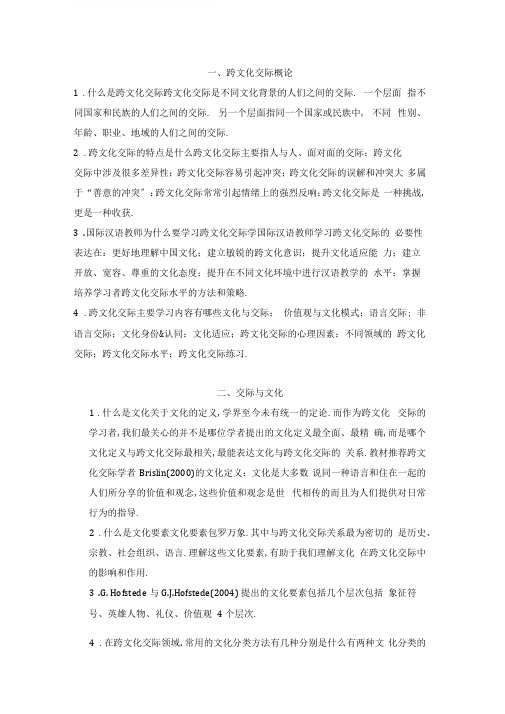
一、跨文化交际概论1.什么是跨文化交际跨文化交际是不同文化背景的人们之间的交际. 一个层面指不同国家和民族的人们之间的交际. 另一个层面指同一个国家或民族中, 不同性别、年龄、职业、地域的人们之间的交际.2.跨文化交际的特点是什么跨文化交际主要指人与人、面对面的交际;跨文化交际中涉及很多差异性;跨文化交际容易引起冲突;跨文化交际的误解和冲突大多属于“善意的冲突〞;跨文化交际常常引起情绪上的强烈反响;跨文化交际是一种挑战,更是一种收获.3.国际汉语教师为什么要学习跨文化交际学国际汉语教师学习跨文化交际的必要性表达在:更好地理解中国文化;建立敏锐的跨文化意识;提升文化适应能力;建立开放、宽容、尊重的文化态度;提升在不同文化环境中进行汉语教学的水平;掌握培养学习者跨文化交际水平的方法和策略.4.跨文化交际主要学习内容有哪些文化与交际;价值观与文化模式;语言交际; 非语言交际;文化身份&认同;文化适应;跨文化交际的心理因素;不同领域的跨文化交际;跨文化交际水平;跨文化交际练习.二、交际与文化1.什么是文化关于文化的定义,学界至今未有统一的定论.而作为跨文化交际的学习者,我们最关心的并不是哪位学者提出的文化定义最全面、最精确,而是哪个文化定义与跨文化交际最相关,最能表达文化与跨文化交际的关系.教材推荐跨文化交际学者Brislin(2000)的文化定义:文化是大多数说同一种语言和住在一起的人们所分享的价值和观念,这些价值和观念是世代相传的而且为人们提供对日常行为的指导.2.什么是文化要素文化要素包罗万象.其中与跨文化交际关系最为密切的是历史、宗教、社会组织、语言.理解这些文化要素,有助于我们理解文化在跨文化交际中的影响和作用.3.G. Hofstede与G.J.Hofstede(2004) 提出的文化要素包括几个层次包括象征符号、英雄人物、礼仪、价值观4个层次.4.在跨文化交际领域,常用的文化分类方法有几种分别是什么有两种文化分类的方法在跨文化交际领域最为常用.一种是客观文化与主观文化.另二种是主导文化与亚文化.5.文化有什么特点呢〔1〕文化是后天习得的.〔2〕文化是共享的,并世代相传.〔3〕大局部文化是无意识的.〔4〕文化是象征的.〔5〕文化是动态的.6.什么是交际与文化的定义相似,关于交际的定义也非常丰富和复杂.教材仅推荐与跨文化交际语用领域相关的定义.即Gudykunst& Kim〔2003〕提出的关于交际的定义:交际是编码和解码的过程,但是这种编码和解码的过程并非单纯的传递和接受过程,而是包含着意义的协商和共建.7.交际的要素是什么交际是互相交往的过程,交际的全部过程包含以下要素:传送者、信息、编码、解码、媒介、反响、噪音.8.交际有什么特点〔1〕交际是象征的〔2〕交际是动态的过程〔3〕交际涉及意义的协商和共建〔4〕交际发生在意识的各个层面.〔5〕交际是特定语境中发生的.9.文化对交际有什么影响文化从两个层面影响交际:一是从文化标准的层面,二是从个人层面.文化影响着人们的感知.首先, 文化影响人们对外部刺激的选择.其次,文化影响人们对外部刺激的分类.第三,文化影响人们对外部刺激的意义联想.最后,文化影响人们对外部刺激的解释.文化的特征值是它为行为提供指南.文化影响人们的饮食行为.文化还影响人们的衣着打扮.文化影响居住方式.文化影响人们的出行方式.文化也影响了人与人交往的方式.1.什么是价值观价值观不是实际的行为, 而是关于行为的规那么;价值观是一套关于什么是真善美的标准系统;这些规那么和标准是用来判断和指导人们的行为的;价值观不是个人的爱好或倾向,而是一种集体的文化意识.2.价值观如何分类一类是终极性价值观, 它是关于生命、生存等终极目标的价值观,另一类是工具性价值观,它是关于道德和水平的价值观.3.价值观有什么特点〔1〕价值观属于深层文化.〔2〕价值观是人们的行为指南. 〔3〕价值观既是稳定的,也是变化的.〔4〕不同文化的价值观既有相同的也有不同的成分.〔5〕价值观被违背时会引起情感上的强烈反响.4.关于价值观模式的研究具有影响力的理论是哪些1.价值取向理论〔由kluckhohn与Strodtbeck提出〕2.文化尺度〔由Hofstede提出〕3.高语境文化与低语境文化〔由Hall提出〕.5.中国文化模式有什么特点〔 1〕集体主义〔2〕以家庭为中央〔3〕尊重传统〔4〕等级观念〔5〕面子观念〔6〕重视人情6.美国文化模式有什么特点〔 1〕个体主义〔2〕平等观念〔3〕强调变化和进步〔4〕物质享受〔5〕科学与技术〔6〕工作与娱乐〔7〕竞争意识四、跨文化的语言交际1概念提要:1.萨丕尔-沃尔夫假说的含义萨丕尔-沃尔有三层含义.〔1〕不同的语言以不同的方式感知和划分世界.〔2〕一个人所使用的语言结构影响他感知和理解世界的方式.〔3〕讲不同语言的人感知世界是不同的.2.语言与价值观之间是什么关系语言与文化的关系最直接的表达是语言表达了人们对世界的看法、态度和价值取向.每种语言都拥有丰富的格言、警句和俗语.这些句子往往就是价值观的表达.3.词义与文化是什么关系在语言的各要素中,词汇与文化的关系最为密切,其对跨文化交际的影响也最为突出.语言的含义不具有普遍性,它受到文化和语境的制约.不同语言和文化的人们进行跨文化交际时,可能会由于对词语含义的误解而产生交流的障碍.4.什么叫委婉语学习它有什么意义禁忌是人类社会普遍存在的文化现象, 人们对诸如生老病死、隐私等许多方面多有避讳,因此产生了大量的委婉语. 了解不同文化中的禁忌和相应的委婉语不仅可以深入理解不同文化的价值取向,也可以防止在跨文化交际中出现不必要的误会.四、跨文化的语言交际2概念提要:1.礼貌原那么包括哪些准那么〔1〕得体准那么〔2〕慷慨准那么〔3〕赞扬准那么〔4〕谦虚准那么〔5〕一致准那么〔6〕同情准那么.2.中国人的礼貌特征包括哪些〔1〕贬己尊人〔2〕称呼准那么〔3〕文雅准那么〔4〕求同准那么〔5〕德、言、行准那么.3.礼貌策略的使用受到什么因素的制约〔1〕说话人与听话人之间的权力距离〔2〕说话人与听话人之间的社会距离〔3〕言语行为的强加程度4.什么是交际风格交际风格是指说话的特点.5.在跨文化交际领域中,常见的交际风格包括哪些〔1〕直接与间接的交际风格〔2〕谦虚与自信的交际风格〔3〕归纳与演绎的交际风格五、跨文化的非语言交际概念提要:1.什么是非言语交际非言语交际不包括语言,而是包括了各种非语言的交际行为;非语言交际具有互动性,涉及信息的发出者和接受者的编码和解码过程;非言语交际是在特定情境中产生的,与语境有密切关系;非语言交际可能是有意的,也可能是无意的.2.非语言交际的功能有哪些〔 1〕传达真实的内在感情〔2〕营造交际印象〔3〕进行会话治理3.非语言交际与语言交际是什么关系非语言交际对语言信息起着重复、补充、代替、标准和否认等作用.4.体态语包括哪些人们的外貌服饰、面部表情、眼神交流、手势、姿势以及身体接触都是体态语,都参与了交际,是非语言交际的一局部.5.时间观念与文化之间有什么联系时间观念是非语言交际的重要维度, 也是价值观的表达.6.什么是单时制文化其特点是什么单时制文化中的时间是线性的,可以向前延伸到未来,向后延伸到过去.单时制文化的人们通过方案和预约来限制时间,在一段时间内只做一件事,强调准时、预约和最后期限.7.什么是多时制文化其特点是什么多时制文化并不把时间看做是线性的.多时制文化中的人认为时间围绕着生活,在同一时间内可以做多件事情.工作常常被打断,方案也常改变.身处多时制文化中的人,维系人际关系和谐远比遵守时间重要.8.人们对于空间的利用与文化之间有什么联系空间利用也是非语言交际的重要内容.空间利用方式表达了特定文化中人际关系的特点.六、文化适应概念提要:1.文化适应策略有哪些同化、别离、融合以及边缘化.2.文化适应是一个复杂、动态的开展过程.短期旅居者的跨文化适应过程分为哪几个阶段蜜月期、挫折期、恢复期和适应期.3.焦虑处理理论认为什么因素影响跨文化适应个体性格因素、社会支持、性别、民族、处理文化适问题的策略等.4.什么是文化休克文化休克是一种因失去了熟悉的社会交往符号而产生的心理焦虑.5.应对文化休克可采取什么策略应对呢广交朋友,建立良好人际关系;学习目的国的语言;了解目的文化的知识;做自己感兴趣的事情;参加社会文化活动;改变自己的思维.6.什么是文化适应假说第二语言教学领域的学者很早注意到了文化适应与第二语言学习的关系.Schuman(1986跟出了文化适应假说〞.他认为, 学习者只有适应了第二文化以后才能习得第二语言,文化适应的程度决定第二语言学习的程度.7.Schuman(198觎出的社会距离的概念是什么社会距离指的是学习者的原有文化与目的语文化之间的差异程度.七、跨文化的人际交往概念提要:1.人际关系与文化的联系表达在哪几方面不同文化间的朋友关系、人情关系、工作关系、与陌生人之间的关系都受到文化的影响.2.交往习俗与文化之间有什么联系在社会交往中,人们需要遵循社交礼仪和规那么,而这些规那么会因文化而异.一种文化中得体、礼貌的规那么到了另一种文化中可能是不得体的,甚至还造成了冒犯.了解不同文化的社交习俗和礼仪,对提升跨文化交际的有效性和得体性是非常有必要的.3.公共礼仪与文化之间有什么联系遵守公共秩序和礼仪是现代人的基本素养,也是一个国家文明程度的表达. 在跨文化交往中,了解和遵守不同文化的公共礼仪非常重要.不遵守公共礼仪会给人留下负面的印象,甚至引起跨文化交往中的冲突.八、跨文化人际交际的心理与态度概念提要:1.什么是刻板印象刻板印象又作成见〞与谊型观念〞,是指一个群体成员特征的概括性看法.2.刻板印象有什么特点〔1〕刻板印象是人们正常思维的一局部.〔2〕刻板印象是文化的一局部.〔3〕刻板印象的最大局限是以偏概全,无视个体差异.3.如何克服刻板印象〔1〕意识到刻板印象的存在.〔2〕改变懒惰和简化的思维习惯.〔3〕扩大与不同文化的人的接触范围.〔4〕试图寻找充分的证据和例外的情况.〔5〕对于来自其他文化的个人的行为的描述,应采用表达性语言,而不是对这一文化群体进行评价和简单概括.4.什么是偏见偏见是对一个群体的成员建立在错误而僵化的概括根底上的负面感情5.如何克服偏见〔1〕坦诚面对自己的偏见.〔2〕扩大与不同文化的人的接触范围.〔3〕参加课程学习和培训.〔4〕在交际中防止使用带有偏见或歧视色彩的表达方式,特别是对弱势群体要注意使用委婉而礼貌的称呼.6.什么是种族中央种族中央指的是在思考和评价别的文化时,把自己的文化放在一切事物的中央位置,并且以自己文化的框架作为衡量的标准.7.什么是文化相对主义文化相对主义是与种族中央主义相对的概念.它最早由美国著名人类学家弗朗兹博厄斯所倡导.其包括两个方面的内容.第一, 每种文化都有自己长期形成的独特历史, 其形态并无上下之分;第二,任何一个民族都有自己的社会思想、世界观和道德观,人们不应该用自己的一套标准来衡量其它民族的文化.。
《跨文化交际》题集

《跨文化交际》题集一、选择题(每题10分,共100分)1.跨文化交际主要研究的是:A. 不同国家之间的政治关系B. 不同文化背景的人们之间的交流与互动C. 国际经济的合作与发展D. 全球气候变化的影响2.在跨文化交际中,哪种行为可能被视为不尊重他人?A. 直视对方的眼睛以示真诚B. 在交谈中频繁点头表示赞同C. 在未经允许的情况下触摸他人的头部D. 礼貌地询问对方的个人生活3.“高语境文化”与“低语境文化”的区别在于:A. 沟通中直接信息的多少B. 人们使用语言的频率C. 社会习俗的复杂性D. 对时间的重视程度4.下列哪项不属于非言语交际的形式?A. 肢体语言B. 面部表情C. 语音语调D. 书面文字5.在一些文化中,沉默可能被视为:A. 同意的标志B. 思考的表示C. 不尊重的行为D. 沟通的一种方式6.“文化休克”通常发生在:A. 一个人长时间处于自己的文化中B. 一个人初次接触并适应新的文化环境时C. 一个人对某种文化有深入了解之后D. 一个人在不同文化之间频繁切换时7.下列哪项是跨文化交际中常见的挑战?A. 语言障碍B. 价值观差异C. 沟通风格的不同D. 以上都是8.在一些文化中,时间被视为一种:A. 可以随意支配的资源B. 必须严格遵守的规则C. 可以用来建立社会关系的工具D. 以上都有可能是,取决于具体的文化9.“面子”在跨文化交际中是一个重要的概念,它通常指的是:A. 一个人的社会地位B. 一个人的自尊心和荣誉感C. 一个人在外貌上的吸引力D. 一个人在经济上的实力10.下列哪项不是促进跨文化交际有效性的策略?A. 增强文化意识B. 发展跨文化沟通技巧C. 避免与不同文化背景的人交往D. 尊重并适应不同的文化习俗二、填空题(每题10分,共50分)1.在跨文化交际中,__________是指由于文化差异而导致的沟通障碍或误解。
2.__________文化强调直接、明确的沟通方式,而__________文化则更注重含蓄和间接的表达。
跨文化交际复习资料
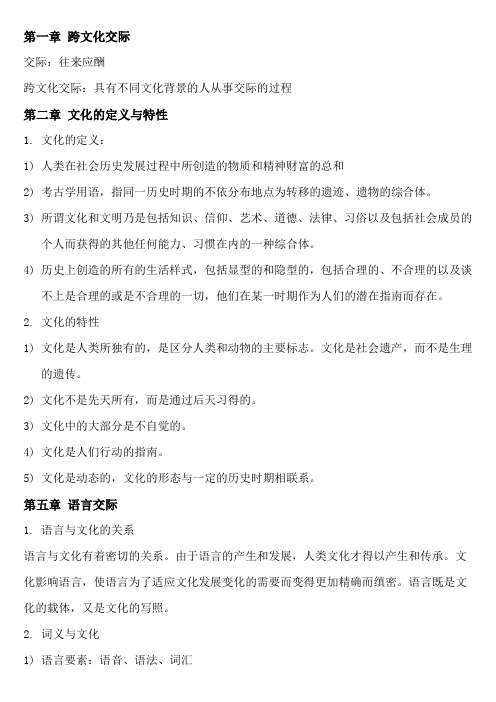
第一章跨文化交际交际:往来应酬跨文化交际:具有不同文化背景的人从事交际的过程第二章文化的定义与特性1.文化的定义:1)人类在社会历史发展过程中所创造的物质和精神财富的总和2)考古学用语,指同一历史时期的不依分布地点为转移的遗迹、遗物的综合体。
3)所谓文化和文明乃是包括知识、信仰、艺术、道德、法律、习俗以及包括社会成员的个人而获得的其他任何能力、习惯在内的一种综合体。
4)历史上创造的所有的生活样式,包括显型的和隐型的,包括合理的、不合理的以及谈不上是合理的或是不合理的一切,他们在某一时期作为人们的潜在指南而存在。
2.文化的特性1)文化是人类所独有的,是区分人类和动物的主要标志。
文化是社会遗产,而不是生理的遗传。
2)文化不是先天所有,而是通过后天习得的。
3)文化中的大部分是不自觉的。
4)文化是人们行动的指南。
5)文化是动态的,文化的形态与一定的历史时期相联系。
第五章语言交际1.语言与文化的关系语言与文化有着密切的关系。
由于语言的产生和发展,人类文化才得以产生和传承。
文化影响语言,使语言为了适应文化发展变化的需要而变得更加精确而缜密。
语言既是文化的载体,又是文化的写照。
2.词义与文化1)语言要素:语音、语法、词汇语音与文化关系最不密切,语法次之,而关系最密切关系最直接的是词汇。
2)有的学者将词汇分为一般词汇和文化词汇(判断区分两种词汇)3.语用规则与文化1)语用规则语用规则就是讲话规则,指根据一定的交际对象、交际场合、交际目的等,对言语形式进行正确选择的规则,是语言的外部规则。
2)语用原则[1]会话合作原则量的准则质的准则相关准则方式准则[2]会话礼貌原则得体准则慷慨准则赞誉准则谦逊准则一致准则同情准则第六章非语言交际1.非语言交际,包括在交际的环境中人为的和环境产生的对于传播者和受传者含有潜在信息的所有的刺激。
2.体态语,是非语言交际的重要组成成分。
3.非语言交际还包括副语言、对时间与空间的利用、味道、颜色等。
跨文化交际考试复习题及答案
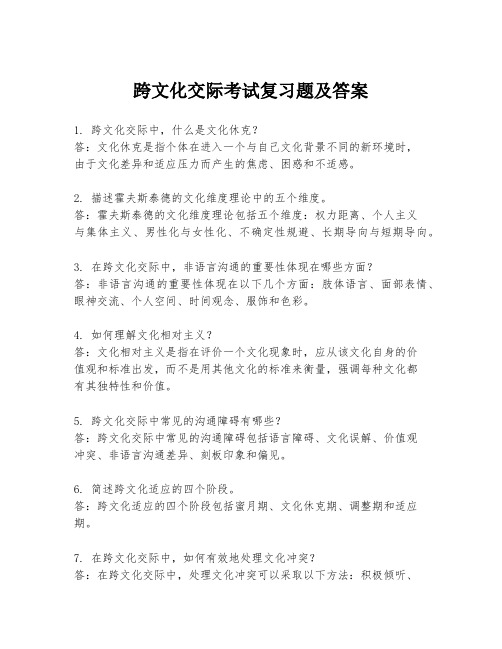
跨文化交际考试复习题及答案1. 跨文化交际中,什么是文化休克?答:文化休克是指个体在进入一个与自己文化背景不同的新环境时,由于文化差异和适应压力而产生的焦虑、困惑和不适感。
2. 描述霍夫斯泰德的文化维度理论中的五个维度。
答:霍夫斯泰德的文化维度理论包括五个维度:权力距离、个人主义与集体主义、男性化与女性化、不确定性规避、长期导向与短期导向。
3. 在跨文化交际中,非语言沟通的重要性体现在哪些方面?答:非语言沟通的重要性体现在以下几个方面:肢体语言、面部表情、眼神交流、个人空间、时间观念、服饰和色彩。
4. 如何理解文化相对主义?答:文化相对主义是指在评价一个文化现象时,应从该文化自身的价值观和标准出发,而不是用其他文化的标准来衡量,强调每种文化都有其独特性和价值。
5. 跨文化交际中常见的沟通障碍有哪些?答:跨文化交际中常见的沟通障碍包括语言障碍、文化误解、价值观冲突、非语言沟通差异、刻板印象和偏见。
6. 简述跨文化适应的四个阶段。
答:跨文化适应的四个阶段包括蜜月期、文化休克期、调整期和适应期。
7. 在跨文化交际中,如何有效地处理文化冲突?答:在跨文化交际中,处理文化冲突可以采取以下方法:积极倾听、尊重差异、寻找共同点、建立信任、使用有效的沟通技巧和寻求第三方调解。
8. 跨文化交际能力包括哪些要素?答:跨文化交际能力包括语言能力、文化知识、社交技能、认知灵活性、情感管理能力和适应能力。
9. 描述跨文化交际中的自我意识。
答:跨文化交际中的自我意识是指个体对自己文化身份和价值观的认识,以及这些因素如何影响跨文化互动和沟通的理解。
10. 跨文化交际中,如何提高文化敏感性?答:提高文化敏感性可以通过以下方式:学习不同文化的知识、参与跨文化交流、反思个人的文化偏见、培养开放和尊重的态度、实践跨文化沟通技巧。
跨文化交际复习资料
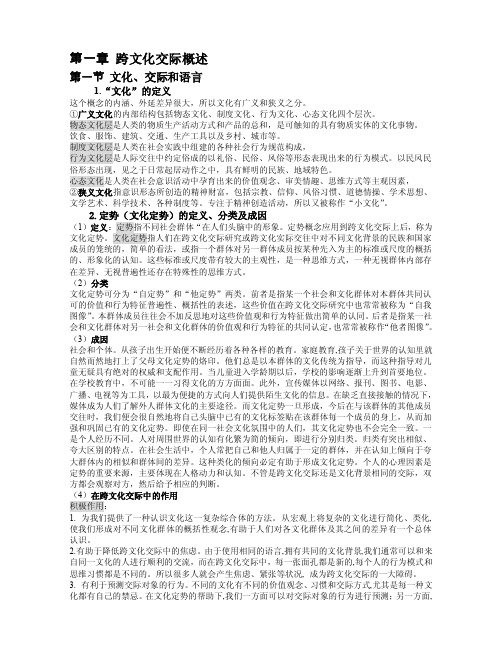
第一章跨文化交际概述第一节文化、交际和语言1.“文化”的定义这个概念的内涵、外延差异很大,所以文化有广义和狭义之分。
①广义文化的内部结构包括物态文化、制度文化、行为文化、心态文化四个层次。
物态文化层是人类的物质生产活动方式和产品的总和,是可触知的具有物质实体的文化事物。
饮食、服饰、建筑、交通、生产工具以及乡村、城市等。
制度文化层是人类在社会实践中组建的各种社会行为规范构成,行为文化层是人际交往中约定俗成的以礼俗、民俗、风俗等形态表现出来的行为模式。
以民风民俗形态出现,见之于日常起居动作之中,具有鲜明的民族、地域特色。
心态文化是人类在社会意识活动中孕育出来的价值观念、审美情趣、思维方式等主观因素,②狭义文化指意识形态所创造的精神财富,包括宗教、信仰、风俗习惯、道德情操、学术思想、文学艺术、科学技术、各种制度等。
专注于精神创造活动,所以又被称作“小文化”。
2.定势(文化定势)的定义、分类及成因(1)定义:定势指不同社会群体“在人们头脑中的形象。
定势概念应用到跨文化交际上后,称为文化定势。
文化定势指人们在跨文化交际研究或跨文化实际交往中对不同文化背景的民族和国家成员的笼统的,简单的看法,或指一个群体对另一群体成员按某种先入为主的标准或尺度的概括的、形象化的认知。
这些标准或尺度带有较大的主观性,是一种思维方式,一种无视群体内部存在差异、无视普遍性还存在特殊性的思维方式。
(2)分类文化定势可分为“自定势”和“他定势”两类。
前者是指某一个社会和文化群体对本群体共同认可的价值和行为特征普遍性、概括性的表述,这些价值在跨文化交际研究中也常常被称为“自我图像”。
本群体成员往往会不加反思地对这些价值观和行为特征做出简单的认同。
后者是指某一社会和文化群体对另一社会和文化群体的价值观和行为特征的共同认定,也常常被称作“他者图像”。
(3)成因社会和个体。
从孩子出生开始便不断经历着各种各样的教育。
家庭教育,孩子关于世界的认知里就自然而然地打上了父母文化定势的烙印。
《跨文化交际》复习材料

《跨文化交际》复习材料跨文化交际是在不同文化背景下进行有效沟通和交流的能力和技巧。
随着全球化的发展,跨文化交际能力变得越来越重要。
下面是一些跨文化交际的复习材料,供参考。
一、了解跨文化交际的基本概念1.跨文化交际的定义和重要性-跨文化交际是指在不同文化背景下进行有效沟通和交往的过程。
-跨文化交际能力是现代社会中不可或缺的一项重要能力,对于成功开展国际业务、扩大国际影响力等都具有很大的意义。
2.跨文化交际的特点和挑战-文化差异:不同国家、地区的文化差异会影响人们的行为习惯、价值观念等方面。
-语言障碍:不同语言的存在会给跨文化交际带来困难。
-礼仪和习俗:不同国家有各自的礼仪和习俗,不同的行为方式可能会因为文化差异而引起误解。
二、了解不同文化的差异和特点1.文化的定义和特点-文化是指一定时期和地区内人们的集体创造的一种总体性且复杂的社会文明现象。
-文化具有包括价值观念、思维方式、行为习惯等在内的多个方面。
2.不同文化的差异和特点-价值观念:不同文化对价值观念的看法和重视程度存在差异。
-社会习俗:不同文化在社会交往、庆祝活动等方面的习俗也存在较大差异。
-沟通方式:不同文化在沟通方式、语言使用等方面也会出现差异。
-时间观念:不同文化对时间观念的重视程度存在较大差异。
三、学习有效的跨文化交际技巧1.尊重对方文化-学习关于对方文化的基本知识,尊重对方的价值观念和习俗。
-避免对对方文化的偏见和刻板印象,保持开放的心态。
2.提升跨文化沟通能力-学习对方语言,尽量使用对方语言进行交流。
-学习不同文化的非语言沟通方式,如手势、面部表情等。
-长辈尊重:在跨文化交际中,尊重长辈是一种常见的礼节。
3.进行有效的文化调适-了解对方文化的特点,根据对方的文化习俗和行为准则进行调适。
-注意语言和行为的表达方式,避免因文化差异造成的误解。
4.增加跨文化交际的意识-了解跨文化交际的重要性,积极寻求跨文化交流的机会。
-提高自身的文化敏感度,增加对不同文化的了解和尊重。
跨文化交际概论复习资料

跨⽂化交际概论复习资料⼀.基本概念理解1、传播就是信息的传送与接收,⼀⽅发出信息,另⼀⽅接受信息,这⼀过程就是传播。
2、亚⽂化:⼜称集体⽂化或副⽂化,指与主⽂化相对应的那些⾮主流的、局部的⽂化现象,指在主⽂化或综合⽂化的背景下,属于某⼀区域或某个集体所特有的观念和⽣活⽅式,⼀种亚⽂化不仅包含着与主⽂化相通的价值与观念,也有属于⾃⼰的独特的价值与观念,并构成亚⽂化等都是这种亚⽂化。
亚⽂化是⼀个相对的概念。
是总体⽂化的次属⽂化。
3、1948年,哈罗德·拉斯韦尔在《社会传播的构造与功能》⼀⽂中,提出了传播过程的"5w"模式,即:(who)谁、(say what)说什么、(in what channel)通过什么渠道、(to whom)对谁、(with what effects)得到什么效果。
4、传播的构成要素:⼀是基本要素:信源、信宿、信息、媒介、信道、反馈。
⼆是隐含要素:时空环境、⼼理因素、⽂化背景和信息质量。
5、线性传播模式的缺陷::单⼀,静⽌。
6、语⾔是⽂化的载体,是⽂化的主要表现形式,就像⼀⾯镜⼦,折射出它所在的社会的思想,习俗和⾏为举⽌。
词汇作为语⾔的重要组成部分,不可避免的带有民族⽂化的积淀,不同国家民族之间的⽂化差异,必然在此上体现出来。
7、概念意义:词语中将其与外部世界的现象联系起来的那部分意义。
即,⼀个词语的字⾯意义中所包含的最基本的,最本质的意义成分就是其概念意义。
8、以英汉语⾔对⽐为例,词汇意义具有以下四个特征:词义基本对应、词义平⾏、词义空缺、词义冲突。
9、语⽤规则就是特定⽂化群体关于语⾔交际的规范与约定,包括说话的时机、说话的内容、说话的⽅式、说话的多少以及⾔语⾏为与⾮⾔语⾏为的配合等诸多⽅⾯。
10、交际风格是⾔语⾏为和⾮⾔语⾏为由于受使⽤中不同交际环境的影响或制约⽽形成的⼀系列交际特点的综合表现。
恰当的交际风格的运⽤对交际过程起着积极的促进作⽤,对交际能⼒的培养也起到重要作⽤。
跨文化交际复习资料
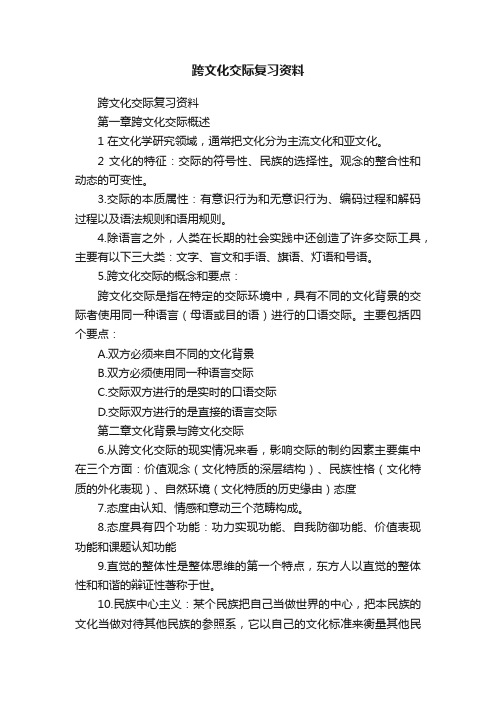
跨文化交际复习资料跨文化交际复习资料第一章跨文化交际概述1 在文化学研究领域,通常把文化分为主流文化和亚文化。
2 文化的特征:交际的符号性、民族的选择性。
观念的整合性和动态的可变性。
3.交际的本质属性:有意识行为和无意识行为、编码过程和解码过程以及语法规则和语用规则。
4.除语言之外,人类在长期的社会实践中还创造了许多交际工具,主要有以下三大类:文字、盲文和手语、旗语、灯语和号语。
5.跨文化交际的概念和要点:跨文化交际是指在特定的交际环境中,具有不同的文化背景的交际者使用同一种语言(母语或目的语)进行的口语交际。
主要包括四个要点:A.双方必须来自不同的文化背景B.双方必须使用同一种语言交际C.交际双方进行的是实时的口语交际D.交际双方进行的是直接的语言交际第二章文化背景与跨文化交际6.从跨文化交际的现实情况来看,影响交际的制约因素主要集中在三个方面:价值观念(文化特质的深层结构)、民族性格(文化特质的外化表现)、自然环境(文化特质的历史缘由)态度7.态度由认知、情感和意动三个范畴构成。
8.态度具有四个功能:功力实现功能、自我防御功能、价值表现功能和课题认知功能9.直觉的整体性是整体思维的第一个特点,东方人以直觉的整体性和和谐的辩证性著称于世。
10.民族中心主义:某个民族把自己当做世界的中心,把本民族的文化当做对待其他民族的参照系,它以自己的文化标准来衡量其他民族的行为,并把自己的文化与其他文化对立起来。
第三章社会环境与跨文化交际11.有效的环境不仅依赖于对文化背景的认识,也依赖于对社会环境的认识,而社会环境对交际来说实际上是广义的“交际背景”12.交际背景主要包括三个要素:交际者:社会地位是决定交际的重要情景因素交际目的:可分为文化型、职业型专业型普通型交际场景:最重要的是物理场景(分时间场景和空间场景)13.社会角色就是某一特定社会群体对某一特定社会身份的行为的期望,人们社会交往从方式到内容都在不同程度上取决于人们的角色关系。
跨文化交际资料

跨文化交际复习资料文化身份(cultural identity)指认为自己归属于某一文化或民族群体的感觉。
文化是人类所独有的,区别于动物。
文化不是先天所有,而是通过后天习得的。
文化中的大部分是不自觉的,隐型的。
文化是人们行动的指南; 文化是动态的。
语境指交际发生的环境,包括自然语境,社会语境和人际语境。
高语境交际(high context communication)是指在交际过程中大部分的信息靠交际人本身传递,只有少量信息被明确地用语言的形式传递。
非语言交际。
一切不使用语言进行交际的活动统称之为非语言交际,包括眼神、手势、身势微笑、面部表情、服装打扮、沉默、身体的接触、讲话人之间的距离、讲话的音量、时间观念以及对空间的使用等等。
空间距离;人际交往的体距可以分为四种,亲密距离(0~45cm):心理学的角度看,这一区域是属于自己的,关系不亲密者进入这一范围就会引起威胁感。
个人距离:距离约为45cm~80cm,这是朋友间谈心的距离,所谈内容一般是个人的私事。
社交距离:相距,这是社交的正常距离,谈论的内容一般非个人事宜。
公共距离:在这种距离内讲话声音很高,谈话内容不涉及个人私事,一般适用于讲课、演说、演戏等场合。
各国人对体距方面的反应是不一样的。
民族中心主义就是按照本族文化的观念和标准去理解和衡量他族文化中的一切,包括人们的行为举止,交际方式,社会习俗,管理模式以及价值观念等。
言语跨文化交际:同文化背景的人用言语进行的交际即言语跨文化交际。
禁忌语指被禁止或避免的具有冒犯性的不礼貌行为。
定势指针对目标群体的成员所持有的(过于简单的)正面或反面的判断。
人们经常认为定势只含有否定贬义的意思。
然而,定势还包括盲目积极方面的判断,例如:认为所有的医生都是聪明机智的。
亚文化是指存在于某一主流文化之中的一种非主流文化,某一少数群体的文化,这一文化中的行为模式区别于主流文化的行为模式。
跨文化交际能力指的是理解和适应目标文化的能力,换句话说,它指的是对于文化多样性的敏感性。
大学英语跨文化复习资料

大学英语跨文化复习资料第一章:文化(1) Culture (from intercultural communication perspective): is the deposit of knowledge, experience, belief, values, actions, attitudes, hierarchies, religion, notions of time, roles, spatial relations, concepts of the universe, and artifacts acquired by a group of people in the course of generations through individual and group striving.(从跨文化交际学角度定义文化:文化是个人和群体在种族发展过程中所获得的知识、经验、信仰、价值观、行为、态度、阶级、宗教、时间观、角色、空间观、宇宙观和艺术品的集合。
)(2) Culture Identity:refers to one’s sense of belonging to a particular culture or ethnic group.(文化身份:认为自己归属于某一文化或民族群体的感觉。
)(3) Subculture: refers to a culture that exists within dominant culture, and is often based on economic or social class, ethnicity, race, or geographic region.(亚文化:指存在于主流文化中的文化,其划分通常基于经济地位、社会阶层、民族、种族或地理区域。
)(4) Co-culture: refers to groups or social communities exhibiting communication characteristics, perceptions, values, beliefs, and practices that are significantly different enough to distinguish them from the other groups, communities, and the dominant culture.(共文化:指具有独特的交际特征、感知特点、价值观、信仰和行为,区别于其他群体、社团以及主流文化的群体或社团。
跨文化交际复习资料
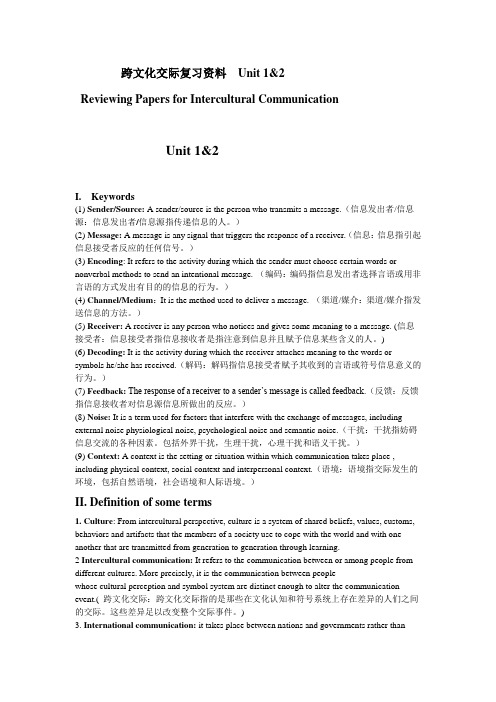
跨文化交际复习资料Unit 1&2Reviewing Papers for Intercultural CommunicationUnit 1&2I. Keywords(1) Sender/Source: A sender/source is the person who transmits a message.(信息发出者/信息源:信息发出者/信息源指传递信息的人。
)(2) Message: A message is any signal that triggers the response of a receiver.(信息:信息指引起信息接受者反应的任何信号。
)(3) Encoding: It refers to the activity during which the sender must choose certain words or nonverbal methods to send an intentional message. (编码:编码指信息发出者选择言语或用非言语的方式发出有目的的信息的行为。
)(4) Channel/Medium:It is the method used to deliver a message. (渠道/媒介:渠道/媒介指发送信息的方法。
)(5) Receiver: A receiver is any person who notices and gives some meaning to a message. (信息接受者:信息接受者指信息接收者是指注意到信息并且赋予信息某些含义的人。
)(6) Decoding: It is the activity during which the receiver attaches meaning to the words or symbols he/she has received.(解码:解码指信息接受者赋予其收到的言语或符号信息意义的行为。
- 1、下载文档前请自行甄别文档内容的完整性,平台不提供额外的编辑、内容补充、找答案等附加服务。
- 2、"仅部分预览"的文档,不可在线预览部分如存在完整性等问题,可反馈申请退款(可完整预览的文档不适用该条件!)。
- 3、如文档侵犯您的权益,请联系客服反馈,我们会尽快为您处理(人工客服工作时间:9:00-18:30)。
1、文化:cultureIt is that complex whole which includes knowledge, belief, art, morals, law, custom, and any other capabilities and habits acquired by man as a member of society.The Characteristics of Culture:Learned、transmitted、Subject to change、unconscious、integrated、symbolic、adaptive.2、跨文化交际:intercultural communicationIntercultural communication means the communication between people from different cultural backgrounds. It is communication between people whose cultural perceptions and symbol systems are distinct enough to alter the communication event.3、高语境文化:High-Context Cultures①Infer information from message context, rather than from content.②Prefer indirectness, politeness and ambiguity.③Convey little information explicitly.④Rely heavily on nonverbal signs.4、价值观:ValuesA standard by which members of culture define what is desirable or undesirable、good or bad、beautiful or ugly、acceptable or unacceptable. V alues are standards set by the members of a society.V alues are often highly contexted. V alues can change significantly over time. V alues can differ within one society and around the world.5、言语交际:verbal communication:It refers to any form of communication that is directly dependent on the use of language.非言语交际:Nonverbal communicationIt will be defined as the process by which nonverbal behaviors are used, either singly or in combination with verbal behaviors, in the exchange and interpretation of messages within a given situation or context.6、本地化:LocalizationThe process of adapting a product or service to a particular language, culture, and desired local “look-and-feel.”Aspects to be considered in localization: Language、Time zones、Money、National holidays、Local color sensitivities、Product or service names、Gender roles、Geographic examples 、Advertisements7、刻板印象:StereotypesA fixed general image, characteristic, etc. that a lot of people believe to represent a particular type of person or thing.Stereotypes are a form of generalization about some group of people, or a means of organizing images into fixed and simple categories that are used to stand for the entire collection of people. It is found in nearly every intercultural situation. The reason forthe pervasive nature of stereotypes is that human beings have a psychological need to categorize and classify.8、文化休克:Cultural shockIt is caused by the anxiety that results from losing all familiar signs and symbols of social intercourse.9、符号:SymbolA person,an object, an event, etc. that represents a more general quality or situation.1、猫头鹰的故事:①This is because Chinese and English native speakers assign different associative meanings to the same bird—owl.②Owl in China is the sign of bad luck. The mere sight of an owl or the sound of the creature’s hooting is enough to cause people to draw back in fear.But in English it is associated with wisdom. In children’s books and cartoons, whenever there is a dispute among birds or beasts, it is the owl that acts as judge.③The term dog elicits different feelings in these two cultures. In China gou(dog) often has derogative meanings, such as 狼心狗肺. But in West is considered the best friend of man, which is well established in their cultures. So the feel disgusted at eating dog meat.④Long(龙) is a symbol of the emperor in ancient China. It has been almighty to us Chinese. Today long is often identified with China or Chinese. But to the English—speaking people, the Chinese long has been rendered in English as “dragon”. Dragon is a fire—spitting monster, cruel and fierce that destroys and therefore must be destroyed.⑤In Chinese ,松、柏、鹤、桃stand for longevity. In English, they are just plants.2、气泡空间:①This is because each person has a “bubble” of space (territory). Studies show that people from South America, Arab countries, and many Asian countries have a smaller personal territory than do North Americans, British and Germans. In Mexican and Arab cultures, physical distance between people when engaged in conversation is very close. In order to feel comfortable while talking, what the Mexican does is to move closer, while what the North American does is to step back a little.②In Western counties, personal territory is highly valued. Each one has his/her own space at home or in office which should not be invaded. In public places, they have “temporary territory”, not be intruded upon either.③As is in the case of human behavior, the use of space is directly linked to the value system of different cultures. The Americans whose culture stresses individualism generally demand more space than do people from collectivistic cultures and tend to take an active, aggressive stance when their space is violated.3、家庭第一:①One of the reason that Annie could not understand Rosa is this::in American culture, the nuclear family is much more important to the individual than the extended family. Most Americans feel little responsibility toward their second cousins, and may never even have met them. Therefore, Annie was confused because Rosa put so much effort into helping “just” a second cousin.②But in Rosa’s culture there is not such a big difference between nuclear and extended family responsibilities. In some countries, the extended family is the main financial and emotional support for people in times of crisis. However, this is not so far most Americans, who rely more on friends, institutions, and professionals.③Another reason is their possession of different cultural values. Rosa felt that “family comes first”, which means that her own needs come second. Annie had a hard time understanding that point of view because in her culture the individual usually comes first. In the United States the person who can “make it on his own”without help from family is respected, although of course many people do get help from their families.④Because of these differences, it is sometimes difficult for people to understand and accept the way family members in other cultures seem to treat each other. It is important, however, to remember that families show their love in different ways. These differences sometimes make it hard to see the reality of family love in every culture in the world.4、男女之间的约会:①Blanca thought that Kevin was going to pay for her because he had invited her to go out, this was the American custom. But things are changing. One reason is that many more American women work today. Therefore, many men and women think it is unfair for men to always pay for everything when they go out.②Another reason is that some women say that if a man pays for them, they feel like they own him something. And some American women prefer to pay because they like to feel like an equal partner on a date. They don’t feel equal if they are taken places and paid for.③Blanca’s understanding that Kevin was going to pay for her is an example of a cultural assumption. Our cultural assumptions are so much a part of us that many times we cannot believe that the whole world does not see things as we do. Trying to understand cultural assumptions that other people make can help to explain their way of thinking and acting.④Most Hispanic parents assume the worst will happen if they let their daughters go out alone with a man. And the Hispanic assumption about women is that they will not be able to stop a man.。
